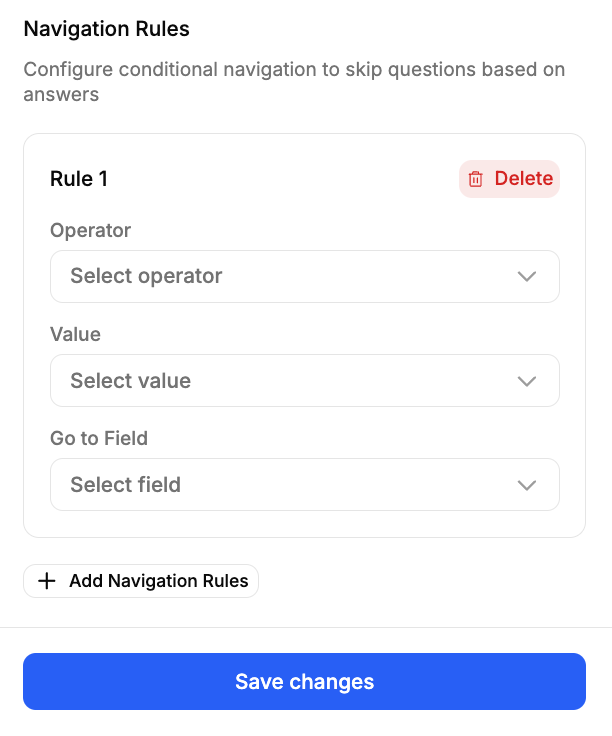Navigation Rules in FeatureOS Forms allow you to create smart, adaptive surveys by skipping, branching, or showing questions based on a user’s response. Available only in Wizard-type forms, this feature makes surveys more dynamic, ensures respondents see only relevant questions, and improves the overall experience.
Here’s how a Navigation Rule looks inside the form builder:

How Navigation Rules Work
A navigation rule is made up of three parts:
Operator – defines the condition type (e.g., equals, contains, is empty).
Value – the specific answer or input to check against.
Go to Field – the next question or section the respondent should jump to if the condition matches.
You can add multiple navigation rules within a single field to cover different scenarios, making the form highly flexible.
Supported Operators by Field Type
Each field type supports different operators depending on the nature of the input. Below are the detailed options:
1. Short Text, Long Text, Email, and URL Fields
Operators available:
Contains / Not Contains – Useful for matching keywords in text responses.
Equals / Not Equals – For exact matches like email or URL.
Is Empty / Is Not Empty – To check whether a respondent skipped a field.
Example: If an Email field is empty, you could skip ahead to a reminder question asking for contact details.
2. Switch Field
Operators available:
Is Checked
Is Not Checked
Example: If a toggle is checked for “I want product updates,” direct the respondent to a preferences section.
3. Number Field
Operators available:
Between
Equals / Not Equals
Greater Than / Greater Than or Equal
Less Than / Less Than or Equal
Example: If Years of Experience > 5, skip junior-level questions and go directly to advanced ones.
4. Date Field
Operators available:
Before / After
Between
On or Before / On or After
Equals / Not Equals
Example: If the date entered is before Jan 1, 2025, direct respondents to legacy product questions.
5. Dropdown, Poll, and Checkboxes
Operators available:
Equals / Not Equals
Contains / Not Contains
Is Part Of / Is Not Part Of
Example: If a respondent selects Python in a “Preferred Language” dropdown, take them to a question specific to Python use cases.
6. Slider Field
Operators available:
Between
Equals / Not Equals
Greater Than / Greater Than or Equal
Less Than / Less Than or Equal
Example: If satisfaction score (0–10) is ≤ 5, skip ahead to a follow-up question asking why the rating was low.
7. Star Rating and NPS Rating
Operators available:
Between
Equals / Not Equals
Greater Than / Greater Than or Equal
Less Than / Less Than or Equal
Example: If NPS score is ≥ 9, direct respondents to a referral section. If ≤ 6, show a feedback text box asking how you can improve.
📌 Why Use Navigation Rules?
Personalization – Tailor the survey flow based on user responses.
Efficiency – Skip irrelevant questions and reduce completion time.
Targeted Insights – Collect only the data that matters for each respondent.
Higher Completion Rates – A smoother experience encourages respondents to finish the form.
🛠 Steps to Apply Navigation Rules
Go to the Designer tab of your form.
Select a field and scroll to the Navigation Rules section on the right panel.
Click Add Navigation Rule.
Choose the Operator (e.g., Equals, Contains).
Enter the Value (the expected response).
Select the Go to Field (the next question to display).
Add more rules if needed.
Click Save Changes.
Need Help?
Email us at [email protected] or drop your question on our support board! 😊
Was this helpful?
